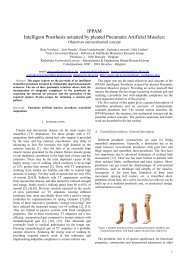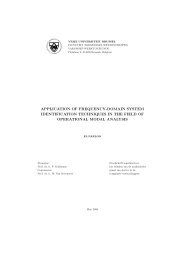VRIJE UNIVERSITEIT BRUSSEL Acoustics - the Dept. of ...
VRIJE UNIVERSITEIT BRUSSEL Acoustics - the Dept. of ...
VRIJE UNIVERSITEIT BRUSSEL Acoustics - the Dept. of ...
You also want an ePaper? Increase the reach of your titles
YUMPU automatically turns print PDFs into web optimized ePapers that Google loves.
92 CHAPTER 5. SOUND INSULATIONMateriaal Densiteit E modulus c L f crit (dikte 10 mm)Aluminium 2.7 70 5367 1192Lood 11.1 16 1265 5057Beton 2.5 48 4618 1385CFRP 1.5 1.5 1054 6071Kurk 0.18 0.032 444 14400Glas 2.5 65 5374 1190Staal 7.8 210 5469 1170PU 1.2 0.025 152 42065Table 5.2: Materiaalparameters en coïncidentiefrequentie van enkele materialenthatinsulationatlowfrequencies isvery bad. Theeffect <strong>of</strong>thislowfrequencycoincidence effect can be reduced by applying an additional material witha high critical frequency (thin material with high speed <strong>of</strong> sound) and areasonable insulation at low frequencies on <strong>the</strong> wall. An example <strong>of</strong> such amaterial is lead foil. For a thickness <strong>of</strong> 1 mm f crit = 50 kHz.The graph that summarizes <strong>the</strong> insulation behavior <strong>of</strong> a wall as a function<strong>of</strong> <strong>the</strong> frequency is shown in Figure 5.5.5.2.4 Insulation <strong>of</strong> double wall constructionsDouble walls are used a lot in constructions. Think <strong>of</strong> double glazing, cavitywalls, ... . The main reason for <strong>the</strong>ir use is <strong>the</strong> high <strong>the</strong>rmal insulation, but<strong>the</strong> acoustic properties are also improved. The following practical guidelinescan be used for double walls :1. By doubling <strong>the</strong> mass <strong>the</strong> sound insulation raises with 6 dB accordingto <strong>the</strong> mass-frequency law (in reality it is only 5 dB). Appart from <strong>the</strong>mass itself <strong>the</strong> air cavity also influences <strong>the</strong> sound insulation :For a distance between <strong>the</strong> walls <strong>of</strong> 2 to 4 cm <strong>the</strong> sound insulationincreases with 4 dB with respect to <strong>the</strong> mass-law.Foradistance between <strong>the</strong>walls<strong>of</strong>5to10cm<strong>the</strong>soundinsulationraises with 9 dB with respect to <strong>the</strong> mass-law.2. The experimental frequency law has now a slope<strong>of</strong> 6 to 8 dB per octave(in comparison to 5 dB for <strong>the</strong> experimental law <strong>of</strong> single walls).3. In <strong>the</strong> cavity in between <strong>the</strong> double walls an acoustic resonance canoccur. This can lead to an important reduction in <strong>the</strong> sound insulationat <strong>the</strong> resonance frequencies.
















